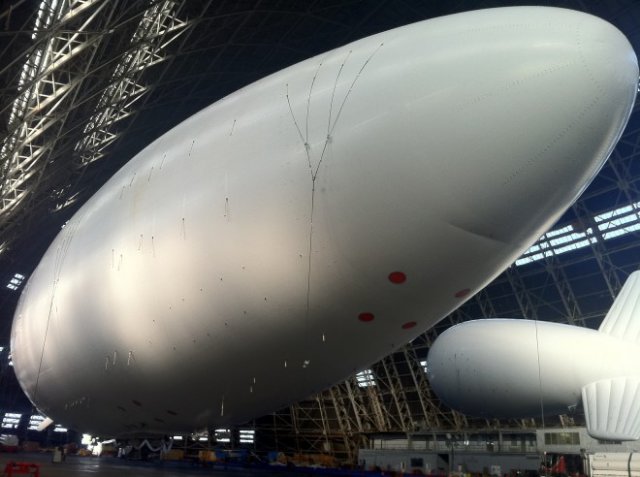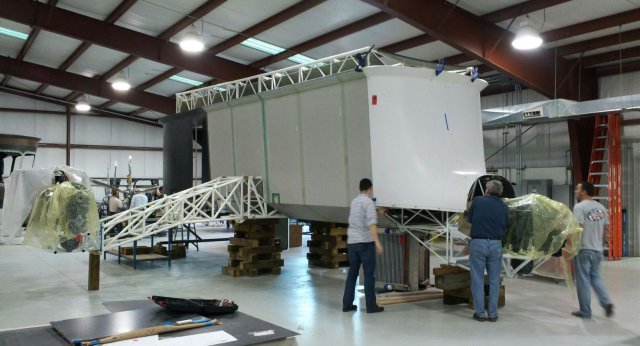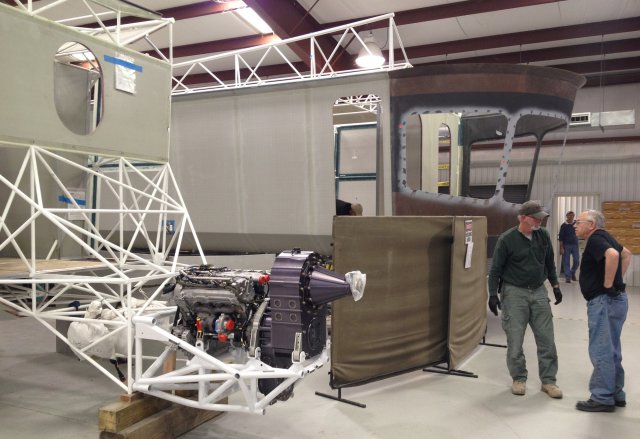The 370-foot-long (123 m), 1.4 million-cubic-foot (37,000 m3) Mav6 M1400 Blue Devil 2 is in final assembly at airship maker TCOM‘s hangar in Elizabeth City, North Carolina. Despite rumours to the contrary, work is still very much underway, with sub-contractor Almaga Composites providing carbon fibre components for the project.
Blue Devil 2 is designed to support continuous missions of up to 216 hours (nine days) operating at an altitude of 20,000 ft, from where the airship, equipped with multiple ISR payloads, will covering an area of 36 square miles at a time, compared with about 16 square miles currently covered by ‘wide area airborne surveillance’ (WAAS) assets. Nine days is the maximum endurance achieved in optimal operating conditions. The actual mission endurance will be determined by environmental conditions in Afghanistan, including payload weight, winds, temperature, barometric pressure etc..
The blimp is equipped with two ducted propellers and a rear manoeuvring engine, all powered by a main diesel generator driving 120 KVA for propulsion and on board systems. The side motors are producing thrust for forward propulsion at a maximum airspeed of 90 knots, or offset wind effect; the rear motor is used to steering airship to maintain the required heading.
The blimp will be equipped with gondola shaped mission modules to be tailored for specific mission. The gondola has multiple attachments for 10- 40 sensors, including electro optical sensors (including wide area airborne surveillance multi-sensor, multi-spectral payloads), high definition motion video cameras, Synthetic Aperture Radar (SAR), Ground Moving Target Indication (GMTI) radar, communications systems, data-links and high power supercomputer platform providing image processing, storage, retrieval and dissemination.
On-board processing will enable the Blue Devil 2 to retain the highest resolution and most detailed imagery without increasing total bandwidth consumption. In addition to storing data on board, the systems will be able to dump the entire imagery to the intelligence control hub, via wideband data-link. Other users will be able to obtain live imagery or past images for forensic analysis) on demand straight from the blimp, within 15 seconds, served via existing Rover or tactical networking. Different gondolas can be integrated into the Blue devil 2 platform in less than four hours.
The picture above shows the BD2 cockpit in NASA Ames’ Vertical Motion Simulator used for pre-qualification training. In unmanned operation, the airship will be flown via UHF satcom from two pilot consoles in a command and control shelter on the ground.
The giant blimp will be able to remain on a mission for five days, with a gondola weighing 2,500 lb. (1.134 ton). Increasing the payload weight to 7,500 lb. (3.4 ton) will reduce mission endurance to three days.
Sources: Defense Update, Wired, LinkedIn, Aviation Week




